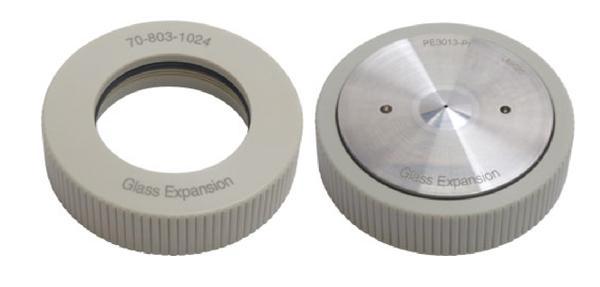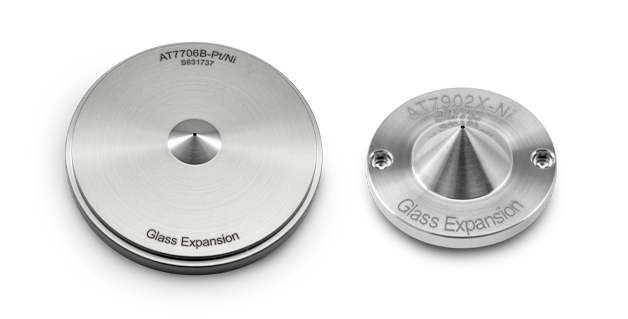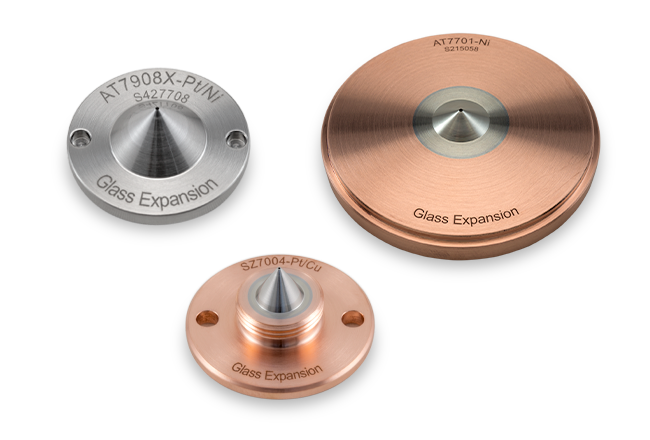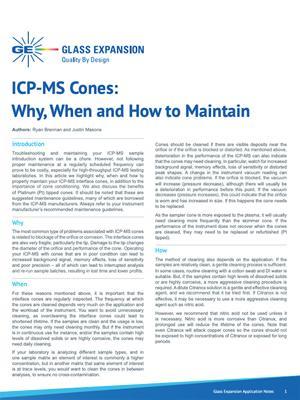Introduction
Troubleshooting and maintaining your ICP-MS sample introduction system can be a chore. However, not following proper maintenance at a regularly scheduled frequency can prove to be costly, especially for high-throughput ICP-MS testing laboratories. In this article, we highlight why, when and how to properly maintain your ICP-MS interface cones, in addition to the importance of cone conditioning. We also discuss the benefits of Platinum (Pt) tipped cones. It should be noted that these are suggested maintenance guidelines, many of which are borrowed from the ICP-MS manufacturers. Always refer to your instrument manufacturer’s recommended maintenance guidelines.
Why
The most common type of problem associated with ICP-MS cones is related to blockage of the orifice or corrosion. The interface cones are also very fragile, particularly the tip. Damage to the tip changes the diameter of the orifice and the performance of the cone. Operating your ICP-MS with cones that are in poor condition can lead to increased background signal, memory effects, loss of sensitivity, and poor precision – all of which can lead to interrupted analysis and re-run sample batches, resulting in lost time and lower profits.
When
For these reasons mentioned above, it is important that the interface cones are regularly inspected. The frequency at which the cones are cleaned depends very much on the application and the workload of the instrument. You want to avoid unnecessary cleaning, as overcleaning the interface cones could lead to a shortened lifetime. If the samples are clean and the usage is low, the cones may only need cleaning monthly. But if the instrument is in continuous use for instance, and/or the samples contain high levels of dissolved solids or are highly corrosive, the cones may need daily cleaning.
If your laboratory is analyzing different sample types, and in one sample matrix an element of interest is commonly a higher concentration, but in another matrix that same element of interest is at trace levels, you would want to clean the cones in between analyses, to ensure no cross-contamination.
Cones should be cleaned if there are visible deposits near the orifice or if the orifice is blocked or distorted. As mentioned above, deterioration in the performance of the ICP-MS can also indicate that the cones may need cleaning. In particular, watch for increased background signal, memory effects, loss of sensitivity, or distorted peak shapes. A change in the instrument vacuum reading can also indicate cone problems. If the orifice is blocked, the vacuum will increase (pressure decrease), although there will usually be a deterioration in performance before this point. If the vacuum decreases (pressure increases), this could indicate that the orifice is worn and has increased in size. If this happens the cone needs to be replaced.
As the sampler cone is more exposed to the plasma, it will usually need cleaning more frequently than the skimmer cone. If the performance of the instrument does not recover when the cones are cleaned, they may need to be replaced or refurbished (Pt tipped).
How
The method of cleaning also depends on the application. If the samples are relatively clean, a gentle cleaning process is sufficient. In some cases, routine cleaning with a cotton swab and DI water is suitable. But, if the samples contain high levels of dissolved solids or are highly corrosive, a more aggressive cleaning procedure is required. A dilute Citranox solution is a gentle and effective cleaning agent, and we recommend that it be tried first. If Citranox is not effective, it may be necessary to use a more aggressive cleaning agent such as nitric acid.
However, we recommend that nitric acid not be used unless it is necessary. Nitric acid is more corrosive than Citranox, and prolonged use will reduce the lifetime of the cones. Note that even Citranox will attack copper cones so the cones should not be exposed to high concentrations of Citranox or exposed for long periods.
Glass Expansion developed the ConeGuard Thread Protector to seal the threads and protect them from corrosion during the cleaning process. The ConeGuard simply screws onto the threaded part of the cone, and O’ring seals prevent any solution from coming in contact with the thread. The ConeGuard (P/N 70-803-1024) is shown with a PerkinElmer NexION Pt sampler cone (P/N PE3013-Pt) in Figure 1.
Pre-soaking the cones in a detergent such as Fluka RBS-25 prior to cleaning with Citranox or nitric acid helps the cleaning process. Citranox is manufactured by Alconox Inc.
and Fluka RBS-25 by Sigma-Aldrich. Fluka is available for purchase through Glass Expansion (P/N
FLUKA25).

Always use safety glasses and protective gloves. Be careful when handling the cone – the tip is very easily damaged. Hold the cone by its edge and only use light pressure with your hand when cleaning the tip. Never use tools for cleaning cones. The cleaning process does not necessarily need to reproduce the original as-new polished appearance. Sample deposits need to be removed, but it is not usually a problem if the cone is discolored. This may actually result in a more stable signal (see Cone Conditioning).
There are three common methods of cleaning cones. The recommended concentrations of the Citranox and nitric acid, and the wash times, should be used as a guide only. Given the wide range of ICP-MS applications and samples, you may need to experiment a little to find the best cleaning procedure for your application. We recommend that you do not use nitric acid any more than is necessary since it will attack the cone materials. If nitric acid is used excessively, the size of the cone orifice may be increased. If this happens, or if the tip is damaged or deformed, then the cone needs to be replaced.
Cleaning Methods
The following cleaning methods are listed from the simplest and gentlest, Method A, to the most thorough and aggressive, Method C.
- Soak the cone overnight in a 25% solution (4x dilution) of Fluka RBS-25.
- Rinse with deionized water.
- Place the cone in a 2% Citranox solution and soak for about 10 minutes.
- Wipe with a soft cloth or Kimwipe dipped in the Citranox solution.
- Wash thoroughly with deionized water.
- Place the cones in deionized water and soak for 2 minutes to remove any residual Citranox.
- Replace the deionized water and repeat the last step at least twice, ie. the cones should be washed at least 3 times, using fresh deionized water each time.
- Rinse with deionized water and allow to dry or blow-dry with clean argon or nitrogen. Make sure the cones are completely dry. It may help to heat them in a laboratory oven at about 60°C.
- Soak the cone overnight in a 25% solution (4x dilution) of Fluka RBS-25.
- Rinse with deionized water.
- Be very careful to avoid damaging the cone tip. The cone should not be placed in the ultrasonic bath without being supported or contained. One way to avoid damage is to place the cone in a ziplock plastic bag half filled with a 2% Citranox solution and float the bag in the ultrasonic bath. Ensure that the bag is floating so that the cone is not resting on the bottom or touching the walls of the bath. This also minimizes the volume of Citranox used since the bath can be filled with water.
- Sonicate for 5 minutes.
- Wipe with a soft cloth or Kimwipe dipped in the Citranox solution.
- Wash thoroughly with deionized water.
- Replace the Citranox with deionized water and sonicate for 2 minutes to remove any residual Citranox.
- Replace the deionized water and repeat last step at least twice, ie. the cones should be washed in the ultrasonic bath at least 3 times, using fresh deionized water each time.
- Rinse with deionized water and allow to dry or blow-dry with clean argon or nitrogen. Make sure the cones are completely dry. It may help to heat them in a laboratory oven at about 60°C.
- Soak the cone overnight in a 25% solution (4x dilution) of Fluka RBS-25.
- Rinse with deionized water.
- Be very careful to avoid damaging the cone tip. The cone should not be placed in the ultrasonic bath without being supported or contained. One way to avoid damage is to place the cone in a ziplock plastic bag half filled with 5% nitric acid and float the bag in the ultrasonic bath. Ensure that the bag is floating so that the cone is not resting on the bottom or touching the walls of the bath. This also minimizes the volume of nitric acid used since the bath can be filled with water.
- Sonicate for 5 minutes.
- Wipe with a soft cloth.
- Wash thoroughly with deionized water.
- Replace the nitric acid with deionized water and sonicate for 2 minutes to remove any residual nitric acid.
- Replace the deionized water and repeat last step at least twice, ie. the cones should be washed in the ultrasonic bath at least 3 times, using fresh deionized water each time.
- Rinse with deionized water and allow to dry or blow-dry with clean argon or nitrogen. Make sure the cones are completely dry. It may help to heat them in a laboratory oven at about 60°C.
After cleaning your sampler and skimmer cones, it is also important to check the condition of the cone consumable parts. Many sampler and skimmer cones rely on a gasket or O’ring to make a proper seal. Installing a new or recently cleaned cone with a worn gasket or O’ring can prevent a proper vacuum and result in rapid overheating of the cone. Some cones require additional screws for installation within the interface. Heavily corroded screws can result in the same issues and, in some cases, result in an elevated iron background since many are made from steel. You do not want to ruin a cone for a $5 O’ring or gasket. We recommend that the sampler gasket be changed each time you change the sampler cone to ensure a proper seal. Regularly check the conditions of the O’rings and replace if they show any signs of cracking.

Cone Conditioning
To ensure the lowest background levels of copper and nickel, conditioning cones before use is recommended. A conditioned cone with a uniform coating will also lead to improved long-term stability. Brand-new cones and cones that have gone through cleaning should be conditioned prior to use.
- 1.0 % nitric acid blank
- 50 ppm calcium in 1.0 % nitric acid
- Aspirate the 50 ppm calcium solution for 10 minutes.
- Change to 1.0% nitric acid blank solution and aspirate for a further 10 minutes.
Another recommended cone conditioning procedure is to aspirate your highest matrix sample for at least 30 minutes, followed by 10 minutes of aspirating your blank or rinse solution. This method is helpful if your laboratory is analyzing a common matrix each day.
Platinum Tipped Cones
When dealing with a high TDS matrix analyzed by ICP-MS, Pt cones are often preferred in place of Ni. The Pt insert runs hotter than Ni, which slows the buildup of salts at the orifice. This allows the ICP-MS analyst to run for longer periods of time before cone maintenance is required. Pt tipped cones are also recommended for analysis of sample matrices with aggressive acids like hydrofluoric (HF), sulfuric (H 2SO 4), and phosphoric (H 3PO 4). For the lowest level detection limits, Pt tipped cones are often used in the semiconductor industry.
For more aggressive samples – e.g., a combination of high TDS and high acid concentration – a sampler cone with a larger diameter Pt insert can be used. For some ICP-MS models, a sampler is available with a 10, 15 or 18 mm Pt insert. The larger insert provides a much greater life due to the larger surface area. One Glass Expansion customer found that the 15 mm and 18 mm inserts would last for 18-24 months compared to 6-8 months with the 10 mm insert, or as long as the orifice was good.
Agilent® ICP-MS instruments have a variety of different cone and skimmer insert combinations to help the laboratory choose which cone option is the best suited for their application. As an example, Glass Expansion’s sampler and skimmer cone options for the Agilent® 7900 ICP-MS are listed in Table 1 and Table 2, respectively. It is recommended that the Pt skimmer cones be used with a brass skimmer base and Ni skimmer cones are used with a stainless-steel skimmer base. Selecting the proper skimmer base helps to prevent overheating and prolong the life of the skimmer cone.
| Description | P/N | Recommendation |
| Nickel sampler cone
|
AT7701-Ni
|
Standard with x-lens, suitable for most applications
|
| Nickel-plated Nickel sampler cone
|
AT7701-Ni/Ni
|
For samples with > 0.5% HCl or for routine operation with UHMI
|
| Aluminum sampler cone
|
AT7701-Al
|
For the lowest nickel background and laser ablation applications
|
| Platinum sampler cone | AT7706-Pt | Standard with s-lens, for lowest detection limits and for higher matrix samples with x-lens |
| Platinum sampler cone (18 mm insert) | AT7706A-Pt | For use with high viscosity, high boiling point acids |
| Nickel-plated Platinum sample cone | AT7706-Pt/NiP | Increased durability for samples with > 0.5% HCl |
| Platinum sampler cone with Nickel base | AT7706-Pt/Ni | Used when cone deposition is rapid due to high TDS |
| Platinum sampler cone (15 mm insert) with Nickel base | AT7706B-Pt/Ni | For use when cone deposition is rapid due to high TDS and increased durability required |
| Description | P/N | Recommendation |
| Nickel skimmer cone for x-lens
|
AT7902X-Ni
|
Standard with x-lens, suitable for most applications
|
| Aluminum skimmer cone for x-lens
|
AT7902X-Al
|
For lowest nickel background and laser ablation applications
|
| Platinum skimmer cone Copper base for x-lens
|
AT7908X-Pt
|
Lowest detection limits and high matrix samples
|
| Platinum skimmer cone Nickel base for x-lens
|
AT7908X-Pt/Ni
|
Organic analysis with x-lens
|
| Nickel skimmer cone for s-lens
|
AT7702S-Ni
|
Economical option for the s-lens
|
| Copper skimmer cone for s-lens
|
AT7702S-Cu
|
Economical option for the s-lens
|
| Platinum skimmer cone Copper base for s-lens
|
AT7708S-Pt
|
Standard with s-lens, aggressive acids and lowest detection limits
|
| Platinum skimmer cone Nickel base for s-lens
|
AT7708S-Pt/Ni
|
Organic analysis with s-lens
|
Platinum Cone Refurbishing
Unlike Ni cones, Pt cones can be economically refurbished several times, as long as the orifice and tip are still in reasonably good condition. This provides an ICP-MS laboratory analyzing high matrix samples with significant cost savings. Glass Expansion offers free refurbishment of the platinum cones that we sell for the life of the cone. Note that, if the orifice is worn to the extent that the diameter is the outside specification, or if the tip is badly damaged, the cone may not be able to be refurbished. In this case, we will give credit for the value of the platinum in the cone that can be used on the purchase of any Glass Expansion products including new cones.
When refurbishing Pt cones, we have to keep in mind that there are many variables that affect whether we can achieve good final repair conditions. This is obviously very much dependent on the condition of the cone when we receive it for initial evaluation.
Glass Expansion’s objective is to first establish whether the cone can be restored or whether it will be recommended for Pt reclaim. Some of the cones can be very badly eroded from the application or cleaning process. However, the eroded area is normally nickel or copper material. As long as it doesn’t affect the seal or mount, it should have no effect on performance – that is as long as the tip is within specification, which is the main part of the refurbishing process. The refurbishing process is dependent on the type of cone and the extent of its damage or wear. Basically, most cones require multiple processes of cleaning, reforming, and machining. Depending on the extent of wear and damage, a damaged tip or orifice can sometimes be reformed to specification.
After refurbishing, the cones are re-evaluated to determine whether the customer can still achieve good use from it. Some cones will look brand-new while others may still look like they are in poor condition, but if they meet our final refurbishment criteria you should still achieve good performance with that particular cone.
Glass Expansion ICP-MS Cones
Glass Expansion has over 30 years of experience in manufacturing ICP-MS sample introduction components and has earned a worldwide reputation for quality and reliability. We are proud to be the first and only ICP-MS cone manufacturer with the required technology and equipment to produce the full range of ICP-MS cones entirely in-house. Glass Expansion’s manufacturing capabilities for this include CNC machining, precision grinding, electron beam welding, and electroless nickel plating. This results in our company being able to maintain the highest level of precision, quality, and reliability standards.
We manufacture ICP-MS cones to the same exacting standards as all of our products, and they are guaranteed to perform to your satisfaction. We supply cones for all of the popular ICP-MS instruments, including models from Agilent Technologies®, Nu Instruments™, PerkinElmer®, Shimadzu®, and Thermo Scientific™. We recently added the Fluidigm Helios TOF-ICP-MS to our ICP-MS cone catalog. These options, along with the corresponding cone raw material, are listed in Table 3. To make sure you get all the support you need, we have a staff of technical experts and a fully equipped ICP-MS laboratory for testing and evaluation.
| ICP-MS Manufacturer | Ni | Ai | Pt | Pt-Boron Free | Cu |
| Agilent Technologies®
|
X | X | X | X | X |
| Fluidigm® (TOF-ICP-MS)
|
X |
|
|||
| Nu Instruments™
|
X |
|
X | ||
| PerkinElmer® | X | X | X | X | |
| Shimadzu® | X | X | X | ||
| Thermo Scientific™ | X | X | X | X |
- Meet or exceed OEM specifications
- Available for all common ICP-MS models
- Satisfaction guaranteed

